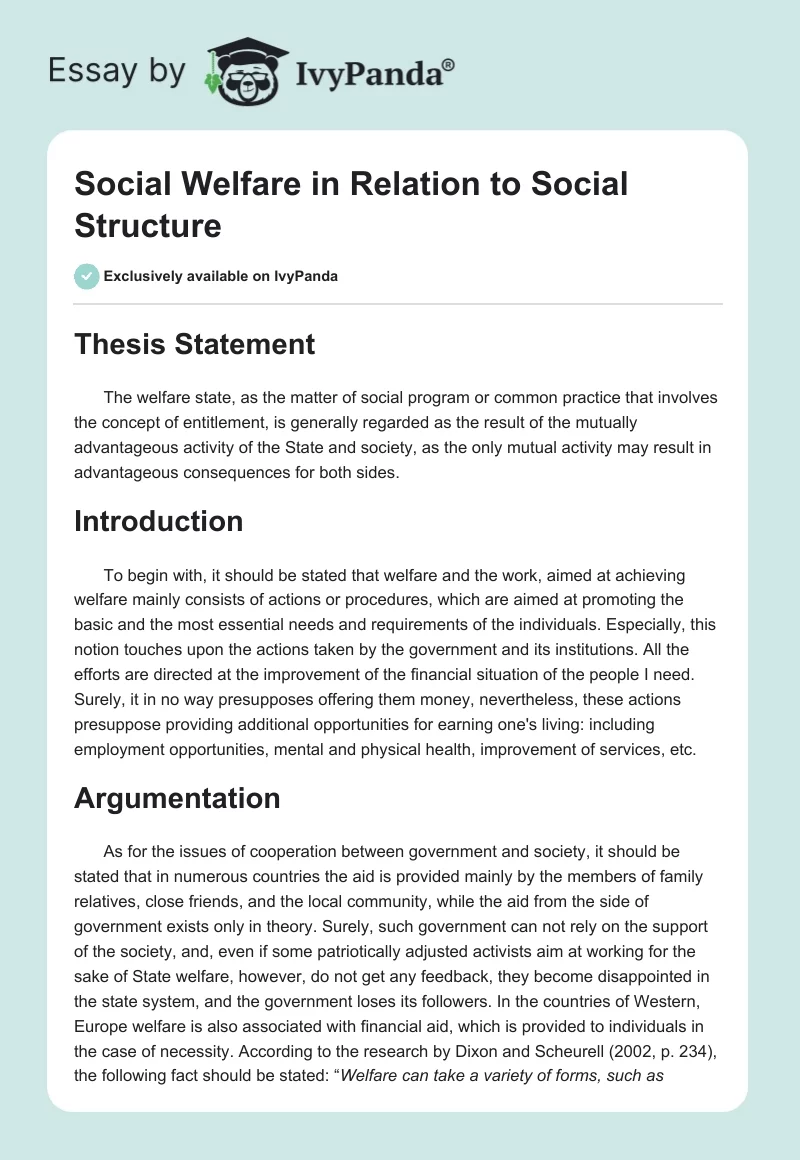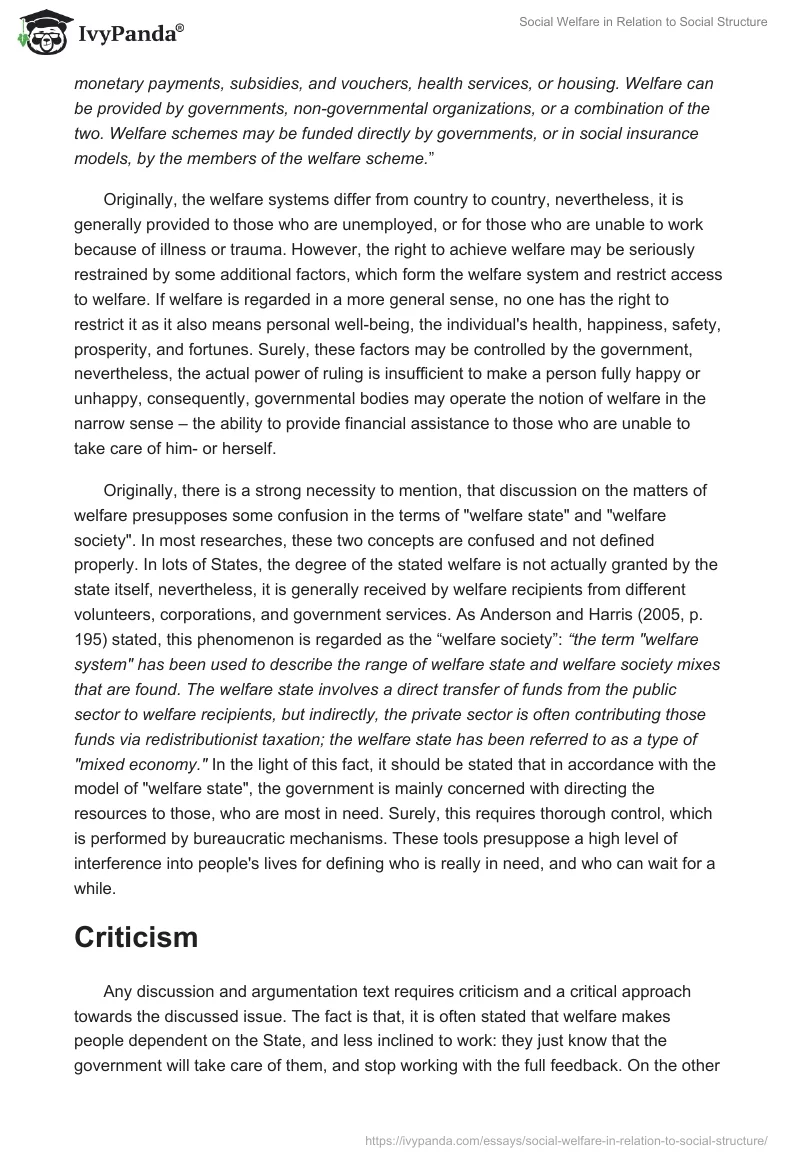Thesis Statement
The welfare state, as the matter of social program or common practice that involves the concept of entitlement, is generally regarded as the result of the mutually advantageous activity of the State and society, as the only mutual activity may result in advantageous consequences for both sides.
Introduction
To begin with, it should be stated that welfare and the work, aimed at achieving welfare mainly consists of actions or procedures, which are aimed at promoting the basic and the most essential needs and requirements of the individuals. Especially, this notion touches upon the actions taken by the government and its institutions. All the efforts are directed at the improvement of the financial situation of the people I need. Surely, it in no way presupposes offering them money, nevertheless, these actions presuppose providing additional opportunities for earning one’s living: including employment opportunities, mental and physical health, improvement of services, etc.
Argumentation
As for the issues of cooperation between government and society, it should be stated that in numerous countries the aid is provided mainly by the members of family relatives, close friends, and the local community, while the aid from the side of government exists only in theory. Surely, such government can not rely on the support of the society, and, even if some patriotically adjusted activists aim at working for the sake of State welfare, however, do not get any feedback, they become disappointed in the state system, and the government loses its followers. In the countries of Western, Europe welfare is also associated with financial aid, which is provided to individuals in the case of necessity. According to the research by Dixon and Scheurell (2002, p. 234), the following fact should be stated: “Welfare can take a variety of forms, such as monetary payments, subsidies, and vouchers, health services, or housing. Welfare can be provided by governments, non-governmental organizations, or a combination of the two. Welfare schemes may be funded directly by governments, or in social insurance models, by the members of the welfare scheme.”
Originally, the welfare systems differ from country to country, nevertheless, it is generally provided to those who are unemployed, or for those who are unable to work because of illness or trauma. However, the right to achieve welfare may be seriously restrained by some additional factors, which form the welfare system and restrict access to welfare. If welfare is regarded in a more general sense, no one has the right to restrict it as it also means personal well-being, the individual’s health, happiness, safety, prosperity, and fortunes. Surely, these factors may be controlled by the government, nevertheless, the actual power of ruling is insufficient to make a person fully happy or unhappy, consequently, governmental bodies may operate the notion of welfare in the narrow sense – the ability to provide financial assistance to those who are unable to take care of him- or herself.
Originally, there is a strong necessity to mention, that discussion on the matters of welfare presupposes some confusion in the terms of “welfare state” and “welfare society”. In most researches, these two concepts are confused and not defined properly. In lots of States, the degree of the stated welfare is not actually granted by the state itself, nevertheless, it is generally received by welfare recipients from different volunteers, corporations, and government services. As Anderson and Harris (2005, p. 195) stated, this phenomenon is regarded as the “welfare society”: “the term “welfare system” has been used to describe the range of welfare state and welfare society mixes that are found. The welfare state involves a direct transfer of funds from the public sector to welfare recipients, but indirectly, the private sector is often contributing those funds via redistributionist taxation; the welfare state has been referred to as a type of “mixed economy.” In the light of this fact, it should be stated that in accordance with the model of “welfare state”, the government is mainly concerned with directing the resources to those, who are most in need. Surely, this requires thorough control, which is performed by bureaucratic mechanisms. These tools presuppose a high level of interference into people’s lives for defining who is really in need, and who can wait for a while.
Criticism
Any discussion and argumentation text requires criticism and a critical approach towards the discussed issue. The fact is that, it is often stated that welfare makes people dependent on the State, and less inclined to work: they just know that the government will take care of them, and stop working with the full feedback. On the other hand, some researchers (Epstein, 2004) claim that there is no direct association between financial performance and welfare expenditures in developed States. Thus, there is no evidence that these states provide the increased rates of progressive social development. Thus, Rothenberg (2004, p. 390) emphasizes the following statement: “the United States spends relatively little on social welfare (less than 17 percent of GDP), in comparison with other countries which spend considerably more. This study claims that on some economic and social indicators the United States performs worse than the Netherlands, which has a high commitment to welfare provision”.
Some political followers resort to very extreme criticism of welfare in the governmental structure. The most extreme views are represented by anarchists and Libertarian Socialists, as both presuppose that all states and governments are absolutely unnecessary or undesirable. Anarchists, in their turn, follow the notion that social welfare grants an essential extent of independence from the market and capitalists, consequently, it originates the dependence of the welfare receivers on the state – an institution that aims to support capitalism. In the light of this fact, it is necessary to give the notion by Blau and Abramovitz (2003, p. 76): “social democrats and anarchists always agreed, fairly generally, on so-called ‘welfare state measures’” and “Anarchists propose other measures to deal with these problems, without recourse to state authority.” Anarchists believe in stopping welfare programs only if it means abolishing government and capitalism as well.” Socialists, in their turn, claim that social welfare is necessary, as citizens of the government deserve assistance in the case of necessity, consequently, welfare should be available to as many citizens as possible, depending on the extent of the need, and the rendered services to the country.
Surely, there are certain exceptions of both views, however, it is stated that the higher levels of social expenses and the levels of welfare in no way impact the economic growth, do not lower the productivity or increase unemployment levels. On the other hand, high levels of welfare can not increase productivity, financial growth, or decrease the levels of unemployment.
The social structure
The final argument should be focused on the issues of social structure and the necessity of welfare, depending on the complexity of the structure. It is beyond doubt, that societies are structured in accordance with the patterns of people’s relationships. Originally, it is argued that social policy is dictated in practice by the prevailing values of community ‑ the matters of family, work, and nation. Epstein, (2004, p, 219) emphasizes the following: “Some countries have policies built on the idea of the man as ‘breadwinner’, with support based on the idea that the marriage is permanent and the woman will not work. Families which deviate from the norm – for example, poor single mothers – are likely to be penalized, though there may also be anomalies in the organization of benefits.” Consequently, it should be stated that the systems of social protection, based on the policies of the breadwinner, depend on stable work and high levels of production. A person should reveal him- or herself as a reliable worker with extensive experience and sufficient length of service. On the other hand, workers who participated in illegal strikes or were dismissed may be deprived of social assistance.
Conclusion
Finally, there is a strong necessity to mention that social welfare is the type of common practice that involves the concept of entitlement. Consequently, it may be regarded as the type of relations among peoples and their governments. Originally, depending on the social structure and the political moods within the population, the attitude towards welfare depends.
References
Anderson, D. K., & Harris, B. M. (2005). Teaching Social Welfare Policy: A Comparison of Two Pedagogical Approaches. Journal of Social Work Education, 41(3), 511
Blau, J., & Abramovitz, M. (2003). The Dynamics of Social Welfare Policy. New York: Oxford University Press.
Dixon, J. & Scheurell, R. P. (Eds.). (2002). The State of Social Welfare: The Twentieth Century in Cross-National Review. Westport, CT: Praeger.
Epstein, W. M. (2004). Cleavage in American Attitudes toward Social Welfare. Journal of Sociology & Social Welfare, 31(4), 177
Rothenberg, J. (2004). The Measurement of Social Welfare. Englewood Cliffs, NJ: Prentice-Hall.


